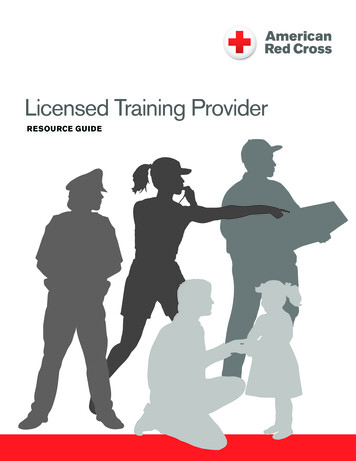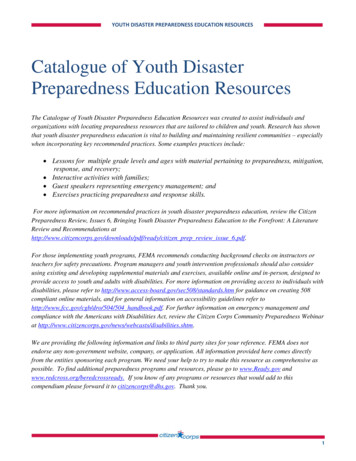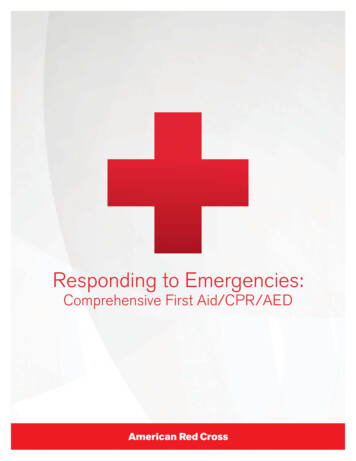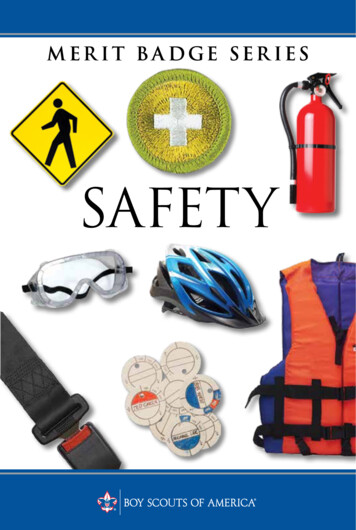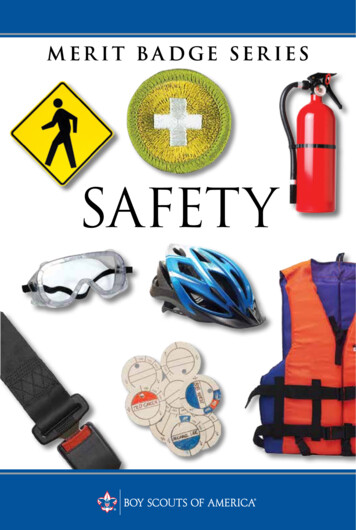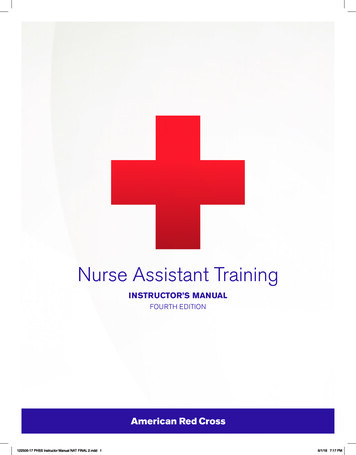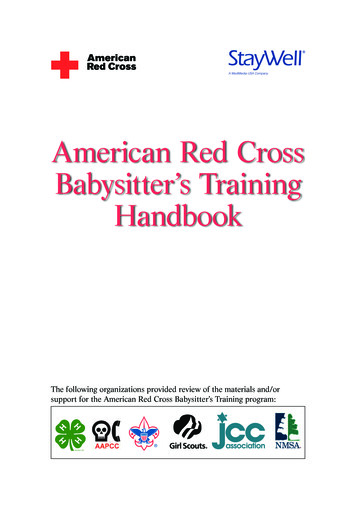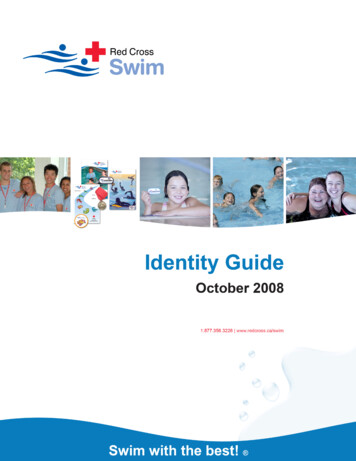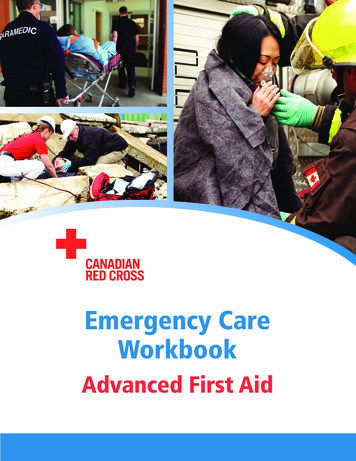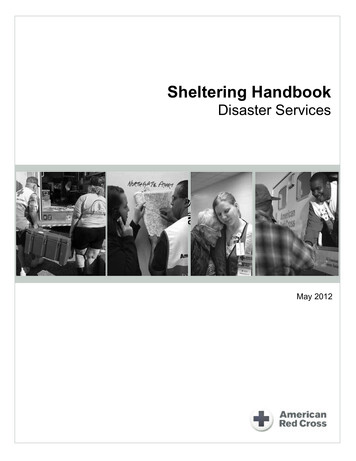
Transcription
Sheltering HandbookDisaster ServicesParticipantParticipantPacketPacketMay 2012
This page is intentionally left blank
Table of ContentsTABLE OF CONTENTS . IINTRODUCTION . IVSHELTERING OVERVIEW . 1-1CHAPTER 1: AN INTRODUCTION TO SHELTER OPERATIONS . 1-1Chapter Overview . 1-1Sheltering Commitments, Philosophy, Guidelines and Requirements . 1-2The Sheltering Cycle . 1-3Shelter Operations Roles and Responsibilities . 1-6Shelter Operation Organization . 1-8Chapter-Administered and Nationally Administered Relief Operations . 1-9Types of Shelter Operations.1-10SHELTER SUPPORT OPERATIONS. 1-12-1CHAPTER 2: SHELTER FACILITIES . 2-1Chapter Overview . 2-1Shelter Facilities Overview . 2-2Identify Shelter Facilities Before Disaster . 2-3Complete a Shelter Facility Survey and Shelter Agreement . 2-5Select a Pre-Identified Shelter . 2-6Complete an Opening Inspection. 2-7Allocate and Set Up Shelter Space . 2-9Operate and Maintain the Shelter Facility .2-12Return the Shelter to the Facility Owner .2-13CHAPTER 3: SHELTER STAFFING . 3-1Chapter Overview . 3-1Plan Shelter Staffing . 3-2Acquire Additional Staff . 3-4Receive Staff at the Shelter . 3-6Manage Shelter Staff . 3-9Transfer or Release Shelter Staff .3-11CHAPTER 4: SUPPLIES AND EQUIPMENT. 4-1Chapter Overview . 4-1Section 1: Acquiring Supplies and Equipment . 4-2Overview . 4-2Complete an Initial Shelter Supply and Equipment Inventory. 4-3Estimate Shelter Supply and Equipment Needs. 4-4Requisition Red Cross Supplies and Equipment . 4-5Procure Supplies and Equipment from the Community . 4-6Respond to Offers of In-Kind Donations . 4-7Section 2: Managing Supply and Equipment Inventories . 4-8Overview . 4-8Receive Red Cross Supplies and Equipment at the Shelter . 4-9Track Shelter Supply and Equipment Inventories.4-10Returning Equipment and Excess Supplies .4-11CHAPTER 5: REPORTING, RECORDKEEPING AND COMMUNICATIONS. 5-1Chapter Overview . 5-1Reporting and Recordkeeping . 5-2Emergency Communications . 5-4i
CHAPTER 6: SAFETY AND SECURITY . 6-1Chapter Overview . 6-1Maintain Safety and Security . 6-2Prepare for and Respond to Emergencies . 6-4Maintain a Positive Shelter Environment . 6-6Respond to Problems at the Shelter . 6-8CHAPTER 7: WORKING WITH PARTNERS AND THE MEDIA . 7-1Working with Partners . 7-1Working with the Media . 7-5SHELTER SERVICES . 7-18-1CHAPTER 8: RECEPTION AND REGISTRATION . 8-1Chapter Overview . 8-1Section 1: Receiving and Registering Clients . 8-2Section Overview. 8-2Prepare the Reception and Registration Areas . 8-4Complete the Shelter Registration Form . 8-6Complete the Initial Intake and Assessment Tool. 8-7Close the Registration Area . 8-8Section 2: Protecting Shelter Resident Privacy and Personal Information . 8-9Section 3: Unaccompanied Minors .8-12Section 4: Registered Sex Offenders .8-15CHAPTER 9: FEEDING . 9-1Overview . 9-1The Feeding Process . 9-2Develop a Feeding Plan . 9-3Procure and Manage Feeding Supplies and Equipment . 9-4Staff the Feeding Operation . 9-5Set Up and Maintain Feeding Areas. 9-6Collect and Report Feeding Statistics . 9-8Close the Feeding Operation . 9-9CHAPTER 10: DORMITORY MANAGEMENT .10-1Setting Up and Monitoring the Dormitory.10-1Close the Dormitory .10-3CHAPTER 11: INDIVIDUAL CLIENT SERVICES .11-1Overview .11-1Work with Disaster Health Services.11-2Work with Disaster Mental Health .11-4Work with Client Casework .11-6CHAPTER 12: BULK DISTRIBUTION .12-1Distribute Bulk Recovery Supplies to Shelter Clients .12-1CHAPTER 13: ADDITIONAL SHELTER SERVICES .13-1Providing Information for Clients .13-2Safe and Well Linking.13-4SPECIAL SITUATIONS .13-114-1CHAPTER 14: ACCOMMODATING INDIVIDUAL NEEDS .14-1Overview .14-1Clients with Disabilities and/or Functional or Access Needs .14-2Children in Shelters.14-7Clients with Ethnic, Cultural, Religious or Language-Related Needs.14-9Clients with Animals . 14-10ii
Pre-Disaster Homeless . 14-12CHAPTER 15: SPECIAL SHELTER CONDITIONS .15-1Overview .15-1Mega-Shelters .15-2Pandemic Outbreak.15-3APPENDIX. A-1Sheltering Tools and Resources . A-1iii
IntroductionWelcomeWelcome to the American Red Cross Sheltering Handbook. In times of disaster, RedCross workers provide safety, shelter, meals and a caring presence to people incommunities around the United States and its territories. By joining the premiershelter organization in the country, you are providing hope and stability toindividuals who need it most.AudienceThis handbook is for workers and supervisors in a Red Cross shelter and workers at achapter who are responsible for establishing a strong shelter system.PurposeThis handbook provides guidance for Red Cross shelter operations, includingsupervision of a shelter. It presents general information about the shelter worker’srole in the sheltering process and the relief operation and includes tools andchecklists to help you plan, open, operate and close a Red Cross shelter. Thehandbook also has guidelines for specific functions, such as setting up a dormitory orregistering a shelter client. Procedures associated with ensuring the readiness of alocal unit to successfully open and maintain a shelter are also included.In thishandbookThis handbook has five parts, described in this table.Part12345DescriptionA Sheltering Overview of Red Cross shelters, including our shelteringphilosophy, the sheltering cycle, and the organization and administration ofshelter operations.Information about Shelter Support Operations, including:Shelter logisticsReporting and recordkeepingStaffingWorking with partners and themediaAn overview of Shelter Services provided to clients, including:Reception and registrationSafe and Well LinkingFeedingIndividual Client ServicesDormitory managementBulk DistributionProviding informationGuidance for Special Situations, including information aboutaccommodating individual needs and unusual shelter conditions.An Appendix, including a list of tools and resources for shelter workers.iv
How to use thisdocumentThis handbook is your primary source for shelter guidance. Use it as a reference in thefield during shelter operations, as a foundation for shelter training and as a review toprepare for your deployment to a shelter. The following table includes tips for how tomake the best use of this handbook.FeatureOnline useDescriptionRead and review this handbook online to ensure you have thelatest information, to conserve resources and to allow full accessto hyperlinked resources. You will find an electronic version ofthe handbook with other Mass Care guidance on the Red Crossintranet.LinksHyperlinks in the handbook will take you to the tools andresources appendix. From there, you can link to the onlineresources that you will need to complete sheltering tasks. Pleasecontact the Mass Care staff at national headquarters to reportproblems with links in this handbook.Shelter manager This handbook provides guidance for all workers in Red Crossresponsibilities shelters and specific guidance for staff supervising the day-today shelter activities. You will find sections throughout labeled―Shelter Manager Responsibilities,‖ highlighting specific tasksfor shelter managers.Requirements The Requirements label identifies Red Cross-required actionsrelated to Red Cross policies. You must follow theserequirements carefully. (See Requirements in the ShelteringOverview.)v
vi
Sheltering OverviewChapter 1: An Introduction to Shelter OperationsChapter OverviewIntroductionThis chapter will help you understand your shelter work and provide a bigger pictureof Red Cross principles, services, structures and processes related to shelters.In this chapterThis chapter includes the following topics:TopicSheltering Commitments, Philosophy, Guidelines and RequirementsThe Sheltering CycleShelter Operations Roles and ResponsibilitiesShelter Operation OrganizationChapter-Administered and Nationally Administered Relief OperationsTypes of Shelter Operations1-1
Sheltering Commitments, Philosophy, Guidelines and RequirementsIntroductionLike all Red Cross services, sheltering activities are guided by the FundamentalPrinciples of the Red Cross and Red Crescent movement and by the MissionStatement of the American Red Cross and Disaster Services Mission Statement. Thissection discusses the foundation of our work in shelters.OurcommitmentOur commitment as shelter workers is to take care of the sheltering needs of peopleaffected by disaster. We are committed to providing shelter on an interim basis whileour clients arrange for their recovery or until they are able to return home. Wedemonstrate this commitment in our sheltering philosophy.ShelteringphilosophyBecause of our commitments to sheltering, we have developed a philosophy thatguides our actions as shelter workers. Individuals we serve in shelters haveexperienced loss and uncertainty because of disaster. It is critical that shelter workerscreate and maintain shelters that welcome and help our clients. The followingstatements reflect our philosophy:Shelters must be places of comfort and safety.Shelters must be readily accessible to individuals affected.All shelter workers must be strong advocates for their clients.Clients must remain proactive participants in recovery.Shelters must provide a safe and secure environment that accommodates thebroadest range of needs in our communities.Our sheltering philosophy is at the heart of each decision we make and each action wetake as shelter workers. Along with the commitments expressed above, it shouldalways guide your work in the shelter.RequirementsYou will find sections in the handbook with the label Requirements. Requirementsidentify a procedure or result that is:Required by a Red Cross policy;Based on our principles;Vital to keeping our commitments to our five constituents: clients, donors, partners,Red Cross workers and the public.Please note all the requirements in the handbook and follow the directions carefully.Examples of requirements you will find in this handbook include:Actions to ensure shelter safety;Standards for protecting client privacy and personal information;Procedures for ensuring that donations to the Red Cross are well spent;Other tasks and results essential to helping us to follow our principles and keep ourcommitments.If you have a question or cannot carry out a requirement, you should ask for helpfrom your supervisor or other shelter leadership.1-2
The Sheltering CycleIntroductionThis section describes the cycle of sheltering that begins with pre-disaster planningand ends with a post-disaster review. It gives you an overview of sheltering, with linksand references to sections of the handbook with more detailed information abouteach phase of the cycle.The shelteringcycleThis diagram illustrates the sheltering cycle. You can read more about each stage ofthe cycle on the following pages.1. Planning andpreparednessPlans and agreementsare established,reviewed and updatedfor use when disasteroccurs.6. After actionreviewWith communitypartners, review theshelter response andmake changes to theplans and agreementsas indicated.2. Opening theshelterA disaster occurs. A RedCross representativemeets with the facilityowner to inspect andopen the facility.5. Closing the shelterClients return home or toother post-disasterhousing. Shelter workerspack up and returnsupplies and equipment,clean and return thefacility to the owner.3. Organizing theshelterStaff arrive, equipmentand supplies areordered, staff and clientareas are set up.4. Operating theshelterClients receive coreshelter servicesincluding registration,assignment todormitories, feeding,Individual ClientServices and familyreunification.1-3
PlanningAn effective shelter operation begins long before a disaster strikes. Every Red Crosschapter is responsible for pre-disaster planning within its jurisdiction.To prepare your chapter for shelter operations, use your chapter disaster responseplan as a guide to identify:The types of hazards that could pose a threat to your community;The demographics of the people who might be affected;Specific needs of your community, including languages spoken and any disabilityrelated and/or functional or access needs people are likely to have;Where shelters may be needed;How many trained workers will be needed and available to run the shelters;What supplies will be necessary.On the basis of this analysis, follow these steps to build your chapter’s shelteringcapacity.Step12345Opening theshelterActionIdentify community facilities for use as disaster shelters. See Identify ShelterFacilities Before Disaster.Complete a pre-disaster Shelter Facility Survey and Shelter Agreement foreach identified shelter and enter shelter information into the NationalShelter System. See Complete a Shelter Facility Survey and ShelterAgreement.Recruit and train sufficient staff to sustain a shelter operation for at least 72hours. See Mass Care Requirements and Resources for guidelines forshelter staff training and qualifications.Set up vendor accounts to provide food and other supplies that will benecessary at the shelter.Prepare shelter kits containing all of the supplies necessary to open and runa short-term shelter. Build your shelter kits from the Shelter Supply KitTemplate.Opening the shelter requires selecting an appropriate available location afterassessing the disaster and the sheltering needs it has caused.A Logistics worker or shelter manager should meet with a facility representative toreview or execute a Shelter Agreement, inspect the facility and open it for Red Crossuse. The shelter manager forwards details about the shelter opening and location tothe relief operation leadership to inform the public and our partners.See Select a Pre-Identified Shelter and Complete an Opening Inspection for moreinformation.Organizing theshelterOrganizing the shelter to provide service to clients requires many tasks includingacquiring necessary supplies and equipment, recruiting sufficient staff and arrangingfor shelter security, if needed. See the chapters on Shelter Staffing, Supplies andEquipment and Safety and Security.1-4
Operating theshelterDuring the operations phase, clients receive reception and registration services,dormitory services, feeding, information, family reunification and individual clientservices. Staff in the shelter assist clients with meeting their immediate disastercaused emergency needs, provide them with information about recovery resourcesand help them develop recovery plans.Other primary responsibilities of shelter staff include reporting importantinformation to relief operation headquarters and keeping accurate records of shelteractivities.See more about these activities in Reporting, Recordkeeping and Communicationsand Shelter Services.Closing theshelterA decreasing shelter population is a sign that it is time to plan closing the shelter. Youand your team will begin the closing process when it is clear that most residents havetaken the next step in their recovery process and arranged for a place to go. To helpthis process, client caseworkers work with shelter residents and with the communityto help find suitable housing.On closing, shelter workers restore the shelter facility to pre-disaster condition bypacking supplies, returning borrowed equipment and cleaning the facility.After-actionreview andplanningThe final step for shelter operations takes us through the sheltering cycle, back topreparedness. By conducting an after-action meeting with shelter staff and partners,chapters can capture the lessons learned through the sheltering process. Theselessons can be used to update plans, training and agreements for future events toimprove our response to the next disaster.1-5
Shelter Operations Roles and ResponsibilitiesIntroductionA shelter operation involves Red Cross staff from many groups and activities inaddition to partners from our communities. Workers may be located at the shelter orat the relief operation headquarters. Use the chart below to understand positions in asheltering operation. In smaller shelters, not all of the positions are necessary, butmost of the tasks will still need to be completed.Managementstaff located atrelief operationheadquartersThe following chart describes roles and responsibilities for staff assigned to reliefoperation headquarters. On a small, chapter-led relief operation, these roles may befilled by the emergency services director, disaster chair, disaster action team captain,volunteer leaders in Mass Care or Sheltering, or other individuals designated by thechapter.PositionRelief operationdirectorAssistant director,Direct ServicesMass Care chiefShelteringmanagerShelteringactivity stafflocated at theshelterResponsibilitiesResponsible for providing operational oversight and directionfor the whole relief operation.Provides administrative support for the Mass Care andIndividual Client Services groups.Manages the Sheltering, Feeding, Bulk Distribution and Safeand Well Linking activities.Acts as the sheltering subject matter expert. Providessupervision and administrative support to all sheltermanagers.Staff at the shelter includes a management team and workers assigned to specificshelter services. Shelter managers can use the following descriptions to assign ibilitiesProvides supervision and administrative support at the shelter;ensures that shelter residents are safe and that their needs are met.Provide supervision and administrative support at the shelter underthe guidance of the shelter manager, as part of the sheltermanagement team.Dormitory Set up sleeping areas, assign residents to sleeping areas andworkerscoordinate with Logistics or the shelter manager to procure suppliesnecessary for a shelter dormitory.Registration Register shelter occupants on arrival, maintain a system for checkingworkersoccupants in and out when they leave and manage the recordkeepingsystem for shelter registrations.Providing Provide clients access to disaster and recovery information andinformation information about shelter rules, routines and services.workers1-6
Staff
Welcome Welcome to the American Red Cross Sheltering Handbook. In times of disaster, Red Cross workers provide safety, shelter, meals and a caring presence to people in communities around the United States and its territories. By joining the premier shelter organizatio
